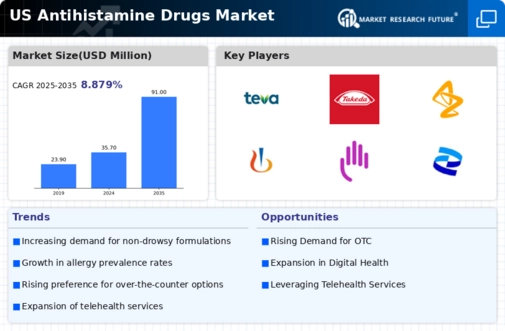Aging Population
The demographic shift towards an aging population in the US is another significant driver for the antihistamine drugs market. Older adults are more susceptible to allergies and respiratory conditions, which increases their reliance on antihistamines. By 2025, it is projected that individuals aged 65 and older will account for nearly 20% of the US population. This demographic is likely to require more antihistamine medications, thereby expanding the market. Additionally, the prevalence of chronic conditions among older adults may further enhance the demand for these drugs, as they often experience multiple health issues that necessitate antihistamine use.
Increasing Allergy Awareness
The growing awareness of allergies among the population is a crucial driver for the antihistamine drugs market. As individuals become more informed about the symptoms and triggers of allergies, there is a corresponding increase in the demand for antihistamines. Educational campaigns and healthcare initiatives have contributed to this awareness, leading to a rise in self-diagnosis and treatment. In 2025, it is estimated that approximately 30% of adults in the US experience allergic rhinitis, which significantly boosts the market for antihistamine drugs. This trend indicates a potential for sustained growth in the industry as more consumers seek effective solutions for allergy management.
Rising Environmental Allergens
The increase in environmental allergens, such as pollen, mold, and dust mites, is a notable driver for the antihistamine drugs market. Climate change and urbanization have contributed to higher levels of allergens in the environment, leading to a surge in allergic reactions among the population. Reports indicate that pollen counts have risen by over 20% in some regions, exacerbating allergy symptoms. Consequently, this trend is likely to drive the demand for antihistamines as individuals seek relief from these environmental triggers. The antihistamine drugs market must adapt to these changing conditions to meet the growing needs of consumers.
Expansion of E-commerce Platforms
The expansion of e-commerce platforms has transformed the way consumers access antihistamine drugs, serving as a significant driver for the market. Online pharmacies and retail websites provide convenient access to a wide range of antihistamines, often at competitive prices. This shift towards online purchasing is particularly appealing to younger consumers who prefer the convenience of home delivery. In 2025, it is estimated that online sales of antihistamine drugs will account for approximately 25% of total sales in the market. This trend indicates a potential for growth in the industry as e-commerce continues to reshape consumer behavior.
Increased Focus on Preventive Healthcare
The growing emphasis on preventive healthcare is influencing the antihistamine drugs market positively. Consumers are increasingly seeking proactive measures to manage their health, including the prevention of allergy symptoms. This shift is reflected in the rising sales of antihistamines, as individuals opt for these medications to mitigate allergic reactions before they escalate. Healthcare providers are also advocating for preventive strategies, which may further drive the demand for antihistamines. By 2025, it is anticipated that the preventive healthcare market will grow by over 15%, thereby benefiting the antihistamine drugs market as more consumers prioritize their health.
























Leave a Comment